A 10 day California background check seems to last forever. Fortunately, a hectic work and home scheduled served as a distraction and helped the time to pass quickly. When I got to Reeds Sporting Goods in San Jose and opened the box, I guess I was a little under whelmed by the contents. If there is one thing missing in a fiberglass stocked gun it’s personality and, in that regard, I’m afraid the Weatherby Ultra isn’t an exception. Where each wood stock may offer variety of appearance in grain, color and tone, each fiberglass stock is virtually a clone of the stock made before it, and the one to follow.
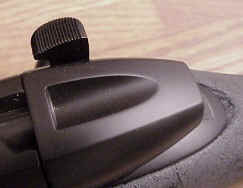 I spent some time familiarizing myself with the gun and looking it over more closely. Overall, the Ultra was a little rough around the edges. The stock inletting behind the receiver was porous and looked unfinished. Without a wood stock as a reference point for firearm quality, I was left only with metallic parts and assemblies as indicators of workmanship. In general, they were nicely finished. The receiver had a smooth uniform matte finish, no odd edges or cheap looking castings.
I spent some time familiarizing myself with the gun and looking it over more closely. Overall, the Ultra was a little rough around the edges. The stock inletting behind the receiver was porous and looked unfinished. Without a wood stock as a reference point for firearm quality, I was left only with metallic parts and assemblies as indicators of workmanship. In general, they were nicely finished. The receiver had a smooth uniform matte finish, no odd edges or cheap looking castings.
The stainless portions were clean and precise with the exception of what has become the traditional Weatherby uneven cartridge stamp on the barrel. The bare stainless isn’t matte, or polished – maybe semi-polished is a better descriptive. I think I would have actually liked a uniform matte black finish covering the entire barrel, like SIG’s treatment of the stainless slides on their P229 pistols. If a rifle is suppose to be functional and reliable in the field, enough to warrant leaving the wood stock behind and going to blob gray fiberglass, shouldn’t it at least have a flat finish on metal parts, and not double as a signal mirror ?
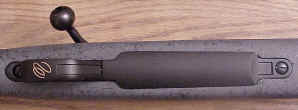 In pursuit of lighter weight, or lower cost, the trigger guard and floor plate are made of aluminum. Everything fits nicely and works reliably, so I’d categorize them as quality functional parts. But I couldn’t help remembering I had just changed to all steel trigger guard and floor plate parts on my little Winchester Compact, because the factory aluminum parts looked so cheesy. Then again, there are a lot of people out there building lightweight rifles who are paying some lightweight rifle specialist an extra grand to carve out billet aluminum parts.
In pursuit of lighter weight, or lower cost, the trigger guard and floor plate are made of aluminum. Everything fits nicely and works reliably, so I’d categorize them as quality functional parts. But I couldn’t help remembering I had just changed to all steel trigger guard and floor plate parts on my little Winchester Compact, because the factory aluminum parts looked so cheesy. Then again, there are a lot of people out there building lightweight rifles who are paying some lightweight rifle specialist an extra grand to carve out billet aluminum parts.
The action is opens and closes smoothly and the safety and hinged floor plate functions correctly and with a positive motion. The CG seems a little far forward; the .240 WM with lighter action and shorter 24″ barrel seems better, but this is a very minor issue that may be corrected with the installation of a scope. If my experience with the Accumark is any basis for forecasting Ultra performance, the gun will work without malfunction for a long period of time, under many types of conditions. I’m glad the rifle has the strength of the full size Mark V action. The Ultra Lightweight is a decent gun, perhaps just a little boring.
Ultra Lightweight….well, Sorta Lightweight
The model reference weight for the Ultra is 6 3/4 lbs., “reference” in that different barrels lengths and bore sizes determine actual model weight. The barrel is a relatively slender contour, but the fluting that contributes to weight reduction stiffens the barrel and increases longitudinal strength, and the increased surface area aids in heat dissipation. The fiberglass stock is very light, however, the use of an interior aluminum frame to join the action and stock make for a very rigid assembly.
 The Ultra Lightweight is not glaringly different than Weatherby’s big magnum, the Accumark. As an example, the H-S Precision stock Weatherby uses for the Accumark is a dark graphite with light gray “spider web” pattern. The design renegades at Weatherby went on to mold the Ultra Lightweight in light gray with a dark graphite “spider web ” pattern.
The Ultra Lightweight is not glaringly different than Weatherby’s big magnum, the Accumark. As an example, the H-S Precision stock Weatherby uses for the Accumark is a dark graphite with light gray “spider web” pattern. The design renegades at Weatherby went on to mold the Ultra Lightweight in light gray with a dark graphite “spider web ” pattern.
I was going to insert a table at this point and list the differences in fiberglass stock dimensions between the Accumark and Ultra, but there were too few; the Ultra has a 3/16″ thinner cheek piece, that’s it. The Ultra shares the balance of it’s stock dimensions with the Accumark. Both models come with quick detachable sling swivels, unless your dealer removes them from the box and tries to sell them back to you.
Locating the 1 3/4 lbs that makes an Ultra not an Accumark takes some digging, and a scale may make a good first step in the process. My Ultra weighed in at 6 lbs 15.8 oz, or 4 oz over the reference model spec. The reference spec includes Ultra’s chambered for the 7mm Remington Mag and .300 Winchester Mag. These have 24″ barrels, and larger bores with more material removed, which makes them lighter and closer to 6 3/4 lb model spec.

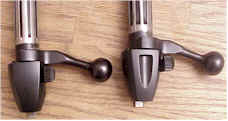 The .257 Ultra retains a full size Mark V action, however, the bolt flutes are deeper and wider than the Accumark to reduce weight. In addition, the rear bolt shroud on the Ultra has been scalloped and the bolt knob has been drilled. The Accumark bolt weighs in at 18.6 oz, the Ultra 17.4 oz. Seems like a lot of work for a little over an ounce, a difference that can easily be eradicated by tossing a baloney and mustard sandwich in your back pack. Fortunately, there is yet another reduction area, perhaps the equivalent of a whole sub sandwich. I really shouldn’t write when I’m hungry.
The .257 Ultra retains a full size Mark V action, however, the bolt flutes are deeper and wider than the Accumark to reduce weight. In addition, the rear bolt shroud on the Ultra has been scalloped and the bolt knob has been drilled. The Accumark bolt weighs in at 18.6 oz, the Ultra 17.4 oz. Seems like a lot of work for a little over an ounce, a difference that can easily be eradicated by tossing a baloney and mustard sandwich in your back pack. Fortunately, there is yet another reduction area, perhaps the equivalent of a whole sub sandwich. I really shouldn’t write when I’m hungry.
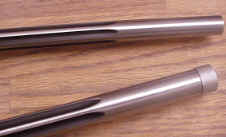 Where the .338-378 Accumark gets a 26″ contour #3 with a .702″ muzzle, the .257 Ultra gets a 26″ contour #2 modified with a .590″ muzzle. The dimensional differential increases as the barrel progresses toward the action.
Where the .338-378 Accumark gets a 26″ contour #3 with a .702″ muzzle, the .257 Ultra gets a 26″ contour #2 modified with a .590″ muzzle. The dimensional differential increases as the barrel progresses toward the action.
The knurled ring on the lower .338-378 barrel protects barrel threads when the Accubrake comes off. The .257 WM Ultra does not have a brake, which seems about right for a gun with 25 ft/lbs of recoil compared to 70 ft/lbs for the .338-378. By calculation, the .257 seems to have almost the same recoil level as my 700 Remington BDL in 7mm Magnum, but experience tells me the Weatherby will be much more pleasant to shoot from a bench. The reason many be the energy absorbing capability of the fiberglass stock, or just the amount of drop, or even the Decelerator recoil pad. I find Weatherby’s reputation of punishing recoil to be more myth than fact.
Conclusion – Aesthetically, I think the Ultra is a relatively mediocre rifle and, like most of Weatherby’s fiberglass stocked products, made worthwhile by an exceedingly strong action and an array of high performance cartridges. Functionally, it’s a great gun, but I do not believe the Ultra comes close to being worth its $1,200 – $1,300 price tag. I made reference to Weatherby’s current absence of modern and recent innovation in the first installment of this series, which I can only reiterate.
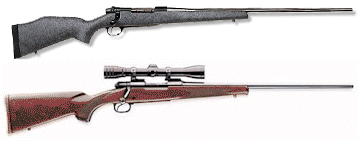
The Model 70 Compact at less than half the price of the Ultra is lighter, cleaner looking in wood, and has a hammer forged barrel and a slick pre ’64 Winchester type action – but it’s only a .243. I could have gone to Remington and purchased one of their Mountain rifles in .25-06 for about the same price as the Compact. On the other hand, the Weatherby packs more punch and won’t end up as a bunch of parts on the ground from using a lot of hot handloads, but it isn’t the most pleasant looking piece of work in my gun rack. I guess the buyer has to decide if the Weatherby cartridge, a few more inches of barrel, and the Mark V action are worth an additional $600 – $700.
The Weatherby .257 Cartridge
The Weatherby Magnum Ultra Lightweight in .257 carries a lot of history. Both the cartridge and the Mark V action are near the half century mark in age; the former a little over, the latter a little under. The .257 Weatherby, the first commercial Weatherby cartridge, still covers more ground faster than any other factory .25, and most .25 wildcats. After correcting early production rifle inaccuracy caused by less than optimal rifling twist rates, and finding a selection of bullets that would hold together on larger game animals, the .257 cartridge went on to become a great success for Weatherby.
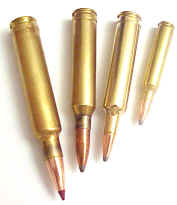 For cartridge size comparison, left to right: .338-378, 7mm Remington Mag, .257 Weatherby Mag, .223 Remington. The .257 Weatherby is a shortened, straightened and necked down .375 H&H case. Not including case neck capacity, on the assumption a bullet will eventually show up and fill that space, the .257 WM shares approximate common capacity with the 7mm Remington Mag, and the .300 and .338 Winchester Magnums – a lot of powder behind a small .25 caliber bullet.
For cartridge size comparison, left to right: .338-378, 7mm Remington Mag, .257 Weatherby Mag, .223 Remington. The .257 Weatherby is a shortened, straightened and necked down .375 H&H case. Not including case neck capacity, on the assumption a bullet will eventually show up and fill that space, the .257 WM shares approximate common capacity with the 7mm Remington Mag, and the .300 and .338 Winchester Magnums – a lot of powder behind a small .25 caliber bullet.
I’m not sure why, but Weatherby seems to not always have the inside track with writers. 13 years after Weatherby’s .257 introduction, Winchester released the .264 Winchester Magnum. The .264 holds less powder and produces less velocity, yet every significant writer in 1958 held up the .264 as the ultimate in velocity. The .264 has died and resurrection has been attempted several times, apparently at the request of few. The last attempt came approximately a year ago. Meanwhile, the .257 Weatherby has been quietly and effectively doing its job through 55 years of continuous production with little written acknowledgement. More recently, this type of history has repeated itself with the introduction of Remington’s .300 and .338 Ultra Mags. Writers draw comparisons between the .300 Ultra Mag Remington and the 50+ year old .300 Weatherby Magnum, while completely ignoring the existence of the more current .30-378 Weatherby, a cartridge that obviously out performs the Remington cartridge. In the case of the .338 Ultra Mag, the comparisons are made to the old .340 Weatherby and the .338 Winchester, while the .338-378 Weatherby goes unmentioned.
There are a few things the Weatherby cartridge has going for it that also make it nice to reload. The Norma brass is very high quality and the primer pockets are CNC machined for close tolerance. They last a long time and stand up to resizing and reloading. Weatherby cartridges have relatively long necks which makes for more concentric bullet seating and more positive case feed and extraction. I honestly don’t know if the Weatherby double radius shoulder helps or hurts gas flow, or if there is an impact on head spacing, or any other functional difference.
The cost of loaded ammo is unnecessarily high. Nosler partition is listed on the Weatherby site at $50 per box of 20 and even ammo made with Ballistic Tips, very inexpensive bullets, are priced at $40 per box. Weatherby ammo does not get heavily discounted when sold through other outlets. Brass is $21 per box. My routine with Weatherby has been to buy a couple of boxes of factory ammo for use in data collection and base lining handloads, then only buying brass and loading my own ammo. By the time I get to the 10th reload of brass, I’m be making quality, premium bullet ammo for $7 – $10 per box.
Accessories
What would a new gun be without a pile of gun to add to the overall cost of ownership ? Here’s where I am so far and I haven’t started reloading yet.
 Shooting Sling: I picked up a Competitor’s Plus sling from Brownells. Just a plain tan adjustable shooting sling with steel hardware and 1.25″ Michael’s Quick Detachable Super Swivels. The sling is longer than standard and may finally force me to practice a variety of shooting positions besides the traditional “sitting at a bench next to a Diet Pepsi and a chronograph. Unless I can get deer to visit me in my living room, the bench position probably isn’t that realistic. The sling is less than $50 with hardware and if you want to check it out it’s stock number 084-270-112.
Shooting Sling: I picked up a Competitor’s Plus sling from Brownells. Just a plain tan adjustable shooting sling with steel hardware and 1.25″ Michael’s Quick Detachable Super Swivels. The sling is longer than standard and may finally force me to practice a variety of shooting positions besides the traditional “sitting at a bench next to a Diet Pepsi and a chronograph. Unless I can get deer to visit me in my living room, the bench position probably isn’t that realistic. The sling is less than $50 with hardware and if you want to check it out it’s stock number 084-270-112.
Scope Mounts: I also picked up Burris twin dovetail mounts and extra high rings from Brownells. There are a few varieties for Weatherby’s, but Brownells tech support was kind enough to promptly provide a correct set of numbers along with instructions for verification based on the Weatherby model and serial number prefix. I know mount selection seems like a trivial issue, but I use to spend a lot of time sending them back to the place I bought them from, either because they were missing screws, or they didn’t fit the scope spacing, or they were the wrong finish. If Brownells prices for mounts and rings are $2 – $3 more for the set, I’ll gladly spend the amount because I know they’ll be right when I get them.
Scope Selection: I didn’t have good luck with the last Vari X III Leupold I bought; it seriously lacked contrast and seemed overpriced for a plain vanilla product. I also noticed street prices have been drifting upward to the point no outlets seem to be offering very attractive pricing on this product. I like the AETEC, but it seemed unnecessarily large for the optical zoom range and objective size, and I think there are functional reasons it’s price is lower than scopes of a similar spec. No problems with the one I purchased, but not the slickest scope in operation. I think the Burris Black Diamond is a bit much, the Mr. T is way too much, and the Nikon line looks a little dated. If I really had any guts I’d buy a Tasco or Weaver.
 I ended up selecting a Burris Signature Scope, based on specs and my personal experience with their variable handgun scopes on large capacity cartridge Contenders. Because I tend to swap scopes around, I wanted to select a range I didn’t currently have and maybe toss in a couple of different features. I picked a 4X16 Signature with an Electro-Dot reticle, Posi Locks, parallax adjustment, and a matte finish. Always wanted a battery powered scope, especially one that weighs as much as the gun it’s mounted on. I’ll cover the scope in specific terms when I’ve had a chance to get to the range, but my understanding is once the electro dot is placed on a target, the bullet will always track to that spot even if the gun or game moves……honest.
I ended up selecting a Burris Signature Scope, based on specs and my personal experience with their variable handgun scopes on large capacity cartridge Contenders. Because I tend to swap scopes around, I wanted to select a range I didn’t currently have and maybe toss in a couple of different features. I picked a 4X16 Signature with an Electro-Dot reticle, Posi Locks, parallax adjustment, and a matte finish. Always wanted a battery powered scope, especially one that weighs as much as the gun it’s mounted on. I’ll cover the scope in specific terms when I’ve had a chance to get to the range, but my understanding is once the electro dot is placed on a target, the bullet will always track to that spot even if the gun or game moves……honest.
Next Installment
I’m going to mount the scope, pick up some more ammo and get up to the range and collect some baseline data on the gun, scope and factory loads. Then I’ll be able to work up a variety of handloads. My primary interest is seeing if I can push something over 4,000 fps down the .25 cal bore, and work up a fast, accurate 115 – 120 grain hunting load.
A couple of closing notes. Lately, I’ve been getting a lot of letters from very nice people just to let me know they are finding useful information on the site. Thank you, I’m very glad the site is doing what it was intended to do and I appreciate the feedback. I also wanted to let people who may be interested know I am working on a message posting section and I will have it up as soon as it works reliably.
More “The .257 Weatherby Ultra Lightweight”:
Pick up Day for the .257 Weatherby Ultra Lightweight
Scope selection for the .257 Weatherby project
.257 Weatherby handloading assessment
The Weatherby Mark V .257 WM at the range
Reloading the .257 WM …in excruciating detail Part I
Reloading the .257 WM …in excruciating detail Part II
Handload Data 257 Weatherby Magnum
Thanks,
Joe

Email Notification